Colin Davis’s 1991 recording of the Requiem – released
to celebrate the three hundredth year of Mozart’s death – returns to
the catalogue. The booklet combines a photograph of traditional Viennese
spires (laced with frosted snow) and modish lower case type. In the
corner, to remind us of RCA’s commitment to the latest technology, a
box announces 24bit/96khz Sound Dimension. The performance enshrined
within is, however, more in keeping with the rooftops than the lower
case – it is weighty, burnished, serious and solemn. There is a fine
quartet of soloists, a splendid orchestra and an even more splendid
chorus who, under chorus master Michael Gläser, are in frequently
inspired form.
The performance will divide critical opinion. Some
will admire its single-minded and deliberate concentration, the grave
and nourishing exploration of text and music, whilst others will find
it insufficiently dramatic, its internal contrasts smoothed out, the
dynamism of the movements elided in the interests of a consonant gravity.
It is a traditional reading, slow and determined but much about it inspires
real praise – the gloriously and powerfully directional Kyrie, the chorus’
magnificent entries in the Dies Irae and their ringingly bright tenors.
Davis moulds the string figuration here with real finesse and encourages
very pleasing results from the Bavarian Radio Symphony Orchestra. The
Tuba mirum introduces bass Jan-Hendrick Rootering – first class in tone
and dramatic impetus – and the bright tenor of Uwe Heilmann. Angela
Maria Blasi has an intrinsically attractive voice but gets off to a
sticky start with her series of glissandi, which are rather too prominent
for comfort. Marjana Lipovšek lives up to her reputation and, with tonal
congruence, blends with her partners to noble effect.
There are some questionable tempo decisions. Though
the soloists are uniformly excellent in the Recordare I can certainly
imagine them happier at a more flowing speed and Domine Jesu Christe
sounds rather dogged – albeit the basses articulate with real freedom.
Still Davis insists on choral diminuendi in the Hostias that sound affecting
without calling attention to themselves and layers string accompaniment
with accustomed and practiced skill. The chorus’ ability to articulate
with clarity whilst also singing very softly is at its most pronounced
in the Agnus Dei where Davis’ ability to arch movements is richly beneficial.
For those who admire performances of this kind – grave
but certainly not marmoreal - this well played and sung disc will be
an attractive proposition. Those seeking a more thrusting and theatrical
performance will look elsewhere – maybe, indeed, to Davis’ own earlier
recording.
Jonathan Woolf

